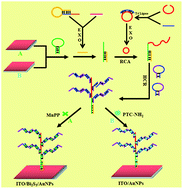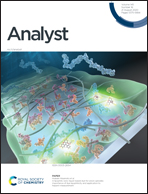A versatile dendritical amplification photoelectric biosensing platform based on Bi2S3 nanorods and a perylene-based polymer for signal “on” and “off” double detection of DNA†
Abstract
A novel versatile dendritical amplification photoelectric (PEC) biosensing platform using Bi2S3 nanorods and perylene-based polymer (PTC-NH2) as double signal probes is proposed for the detection of trace target DNA. Bi2S3 nanorods as efficient photoactive materials were firstly immobilized on the Au nanoparticle (NP) modified electrode and generated a high PEC signal. Exonuclease III (Exo III)-assisted target recycling generated a large number of DNA product chains (PC), PC hybridized with hairpin DNA (H1) on AuNPs/Bi2S3/ITO, and then triggered rolling circle amplification (RCA) and the hybridization chain reaction (HCR) to form the dendritic structure with abundant DNA duplexes. After large amounts of Mn(III) meso-tetra(N-methyi-4-pyridyl)porphine pentachloride (MnPP) were embedded in the dendritic structure, they efficiently quenched the PEC signal, realizing the “signal off” detection of the target. In addition, the dendritic structure was also formed on AuNPs/ITO, and large amounts of PTC-NH2 molecules as the PEC probe were inserted into the dendritic structure, achieving a highly enhanced PEC current for the “signal on” detection of the target. This biosensing platform with double signals exhibits good analytical performance with wide linear ranges. This study develops a new DNA nanostructure-amplified versatile PEC sensing platform for bioanalysis, with promising potential for application in gene therapy and clinical analysis.



 Please wait while we load your content...
Please wait while we load your content...